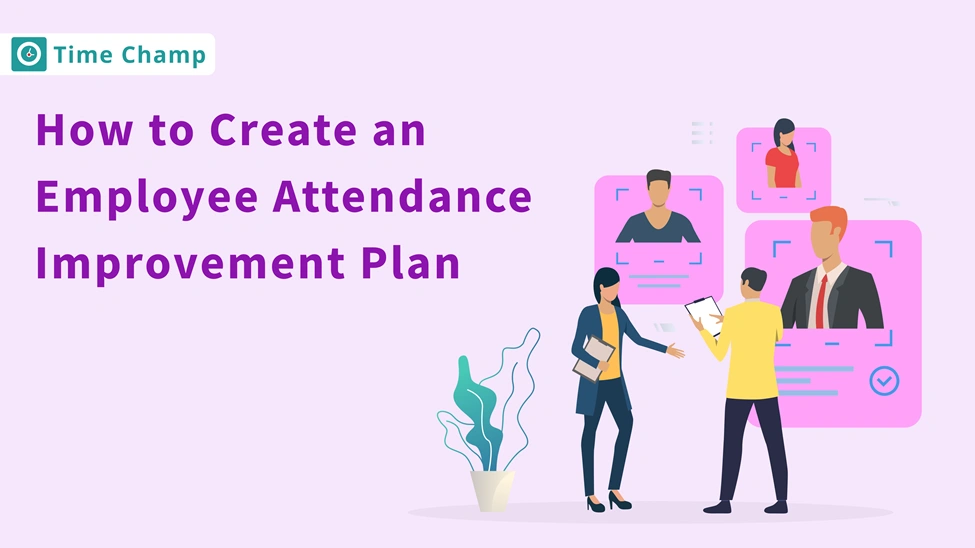Having difficulties dealing with recurrent attendance issues in your team? An Employee Attendance Improvement Plan may be the answer you are looking for. It’s not only about setting rules, but also about creating accountability, providing support, and building a workplace culture that values reliability.
Regardless of whether the problem is repeated absences, tardiness, or inconsistent attendance patterns, an employee attendance improvement plan works to correct the issue in a timely and fair way. In its proper form, it improves communication, increases team morale, and creates clear expectations.
Ready to learn how to make one that actually works? Let’s dive in.
What is an Employee Attendance Improvement Plan?
An Employee Attendance Improvement Plan is a structured approach used by employers to help employees improve their attendance by setting clear expectations and consequences, offering support, and tracking progress over time. It aims to reduce absenteeism, boost accountability, and create a more reliable and productive work environment.
How AIP Helps Your Team?

Here are the main benefits of an Attendance Improvement Plan which can be used to improve the attendance and productivity of both employees and organizations.
Promotes Accountability
An Employee Attendance Improvement Plan will ensure that people exercise accountability since the expectations are clearly stated. Employees learn about their responsibility for good attendance and are inspired to assume responsibility for punctuality and presence at the workplace.
Improves Productivity
This plan enhances productivity because it reduces absenteeism and limits the interruptions in the flow of work. When the employees report for work regularly, teams can work effectively without missing deadlines and objectives.
Ensures Fairness
A good attendance plan ensures equality as it applies the same standards to all employees. This uniformity does away with favoritism and bias, resulting in an equal environment whereby all people are subjected to the same attendance regulations.

Supports Employees
The plan supports the employees by identifying those problems that can impact their attendance and which resources or accommodations are appropriate. Rather than punishment, it offers help with flexible schedules or counseling to help employees to do better in their attendance.
Strengthens Team Morale
Through the promotion of consistent attendance, the plan increases the team morale. Continued participation from all members of the team establishes trust, cooperation, and makes the work environment friendlier and more balanced.
Prevents Future Issues
An attendance improvement plan avoids future problems by eliminating attendance problems early before they become serious. Early intervention helps to prevent a frequent absenteeism and stabilize productivity.
Enhances Communication
This plan strengthens communication by encouraging open and honest dialogue between managers and employees. Open communication about attendance requirements and issues can easily resolve them and create better workplace relationships.
Key Steps to Build an Effective Attendance Improvement Plan

A good Attendance Improvement Plan involves more than just making rules. This is how you make a plan that supports the workers and delivers genuine outcomes.
Identify Attendance Issues
Start by looking at attendance records to see if there are patterns of missing a lot of days, often arriving late, or leaving early. Monitor for signs that might lead to any personal, medical, or work-related concerns. Determining the causes of absenteeism is the first step in addressing it.
Engage in Communication
When the issue is clear, set up a meeting in private and with respect to talk about it with the employee. Try to ask questions that encourage your employees to explain their worries and pay attention to what’s worrying them. This way, the manager can earn the employee’s trust and find out if missing days are caused by anything.
Set Clear Objectives
Ensure your attendance goals are specific and can be achieved. Here’s an example, “Just one absence that is not excused in the coming 30 days is allowed.” Let the employee know what they need to accomplish and the way their success will be evaluated. By having clear goals, the employee knows exactly what they are supposed to do.
Provide Support
The help and support from other employees really matters. It may require a manager to change work schedules, provide remote work options, point out employee assistance programs, or just check in with employees regularly. Being open to helping employees encourages them to get better.
Define a Timeline
Set a length for the plan, whether it is 30, 60, or 90 days. It shows both the manager and the employee how much time is available for their work and when to check the results.
Document the Plan
Put everything in writing: attendance issues, goals, support provided, work timeline, and consequences. Give a copy of it to the employee. Documentation creates accountability and protects both sides if further action is needed later.
Monitor and Review
Employers can use automatic spreadsheets, HR software, or Time Champ to track employee attendance. Have regular talks to check on progress, offer help, and make any changes that are needed. Watching over the plan every day ensures it stays on track.
Implement Consequences
If your support and clear communication do not help, start using your company’s disciplinary process. These consequences can be a warning, suspension, or in the harshest situations, getting fired. Following through with consequences helps make sure employees understand how important it is to attend class regularly.
Challenges You Might Face While Creating This Plan
Here are some common issues with developing an Attendance Improvement Plan that may influence its success and effectiveness.
Identifying Root Causes
In order to solve the attendance problems, you first should know why they are occurring. It might be personal problems, employee burnout, lack of engagement, or even ambiguity of policies. If you are not aware of the underlying cause, then your plan may not address the actual problem.
Setting Realistic Goals
The employees can be disappointed if the set goals are too strict or unrealistic. The plan should have practical goals that can be measured and encourage improvement without causing pressure.
Maintaining Consistency
Create an attendance plan that is same for everyone, so it doesn’t seem unfair or confusing. When the plan is consistent, it builds trust and helps employees know they’re being treated equally. It also makes the plan easier to follow and more effective.
Gaining Employee Trust
Building trust with employees is key to improving attendance. If employees feel that guidelines are fair and consistent, they tend to cooperate and remain committed.
Thoroughly state that the plan is meant to help support their success and enhance communication as well as to build a more equal working environment, and not to punish them. This earns trust and promotes cooperation.
Tracking Progress
To know whether the plan is working, you have to monitor attendance records closely. Frequent and precise tracking reveals where improvements can be made and where they are not. It also allows you to adjust the plan when it is necessary to make adjustments.
Balancing Support and Accountability
Finding a balance between support and accountability is quite important but also quite tricky. It means supporting employees with advice, tools, and also making what is expected of them clear. A good plan not only establishes rules, it helps employees when necessary but also holds them accountable for their actions.
Make Attendance Tracking Easier with Time Champ
Manually recording attendance takes a lot of time and often leads to errors. This is when Time Champ comes in handy. It makes it simple for companies to keep track of employee attendance easily and without errors.
With features like real-time tracking, attendance management, detailed reports, and easy integration, Time Champ helps you easily understand your employees’ attendance patterns.
It can be used in any type of work setting, whether teams are remote, hybrid, or in the office. Managers can customize the rules, get notified automatically when someone doesn’t show up or logs in late, and even configure alerts for late logins based on company settings. You can also download detailed attendance reports to review employee attendance patterns and share them easily with HR or payroll teams.
Time Champ makes things easier for you, no matter the size of your company, by helping you save time, reduce paperwork, and increase the effectiveness of your employee attendance improvement plan.
Conclusion
To make an effective Employee Attendance Improvement Plan, focus on helping and encouraging, rather than punishing employees. When you notice attendance issues early, stay open about it, help the person improve, and track their advancement, then you can create a workplace people look up to.
With the right tools, like Time Champ, you can track attendance easily with features like automatic alerts, accurate time tracking, and smart attendance management, you can focus more on growing your team. An effective plan for attendance not only addresses employee attendance issues, it also makes team members feel positive, builds team relations, and establishes a foundation for future success.
Frequently Asked Questions
Yes, creating an attendance improvement plan that fits each role or department can help improve its effectiveness. Because various jobs have different needs, adapting to the plan can help solve the attendance issues faced by each group.
Using attendance tracking software, it becomes a lot more convenient to keep attendance records. It notifies you in real-time and sends alerts to help you avoid making mistakes. It enables managers to see if anything is wrong at an early stage, aid their employees, and stick to arranged plans better.
One way to notice success is when there is less absenteeism and tardiness among employees. If your team’s outlook improves, work results go up, and employees share positive feedback, it means your plan is working well.
Working flexible hours is important, especially for those who have problems getting to their job before regular hours. More flexible schedules for employees can help them relax, become more efficient, and reach work on time the majority of the time.
A good company culture in which employees are made to feel appreciated, respected, and encouraged can actually influence whether or not they wish to report to work. When individuals enjoy their job and believe that what they do matters, they tend to want to go to work and perform well.








